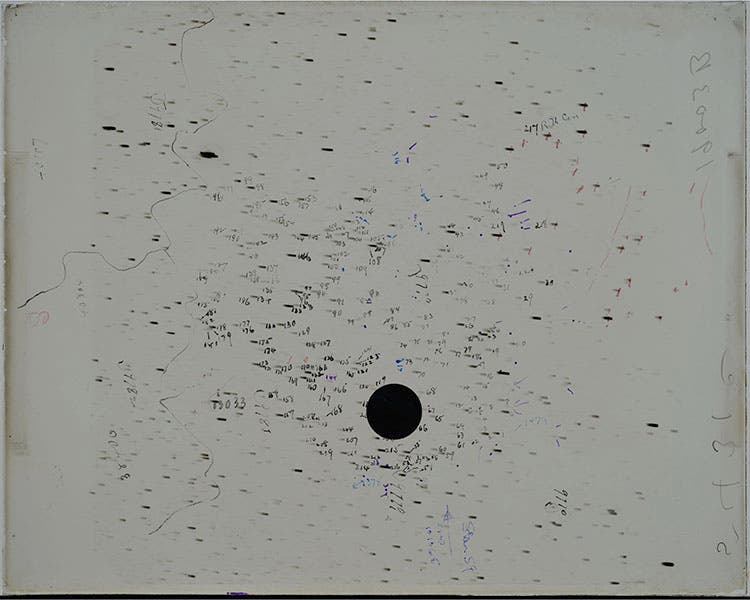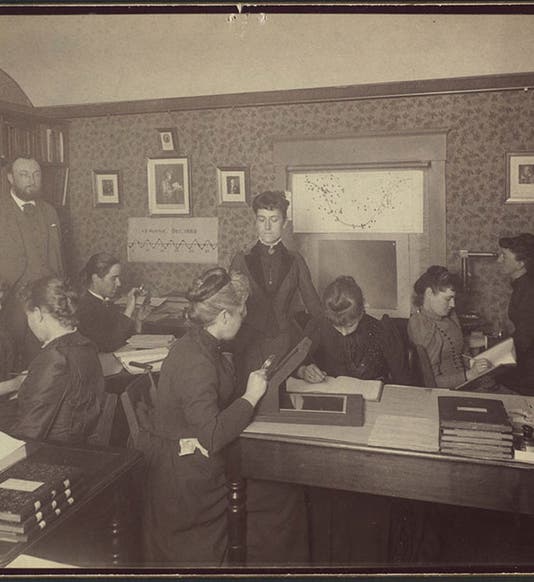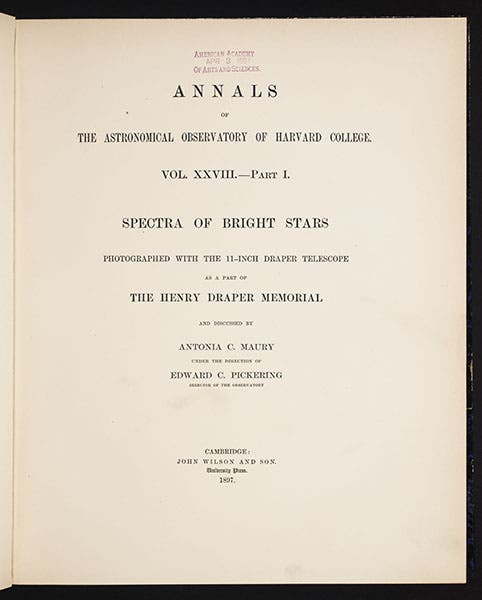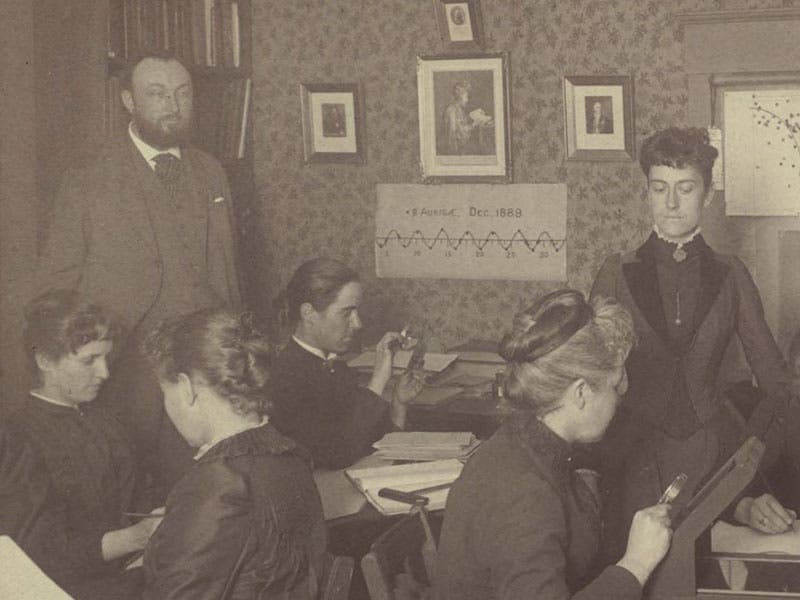Scientist of the Day - Antonia Maury
Antonia Maury, an American astronomer, was born Mar. 21, 1866. There were few women in the 19th century who were better prepared for a scientific career than Miss Maury. Her grandfather was John William Draper, a pioneering astro-photographer, and her maternal uncle was Henry Draper, who took the first photograph of the spectrum of a star, and who was our Scientist of the Day several weeks ago. In addition, an uncle on her father's side was Commander Matthew Fontaine Maury, first director of the United States Naval Observatory. So when Antonia went to Vassar, it is not surprising that she chose astronomy as her field of study, and it didn't hurt that Maria Mitchell, the first great woman astronomer in the United States, was still teaching at Vassar. Antonia became one of Maria's prize pupils. After she graduated, Antonia was invited by Edward Pickering to join his staff at Harvard College Observatory, where he had been putting together a complement of female "computers" to analyze the photographs of stellar spectra that were beginning to accrue in the Observatory's plate rooms. She accepted and began work there in 1888. The financial resources were provided by the Henry Draper Memorial, a fund established by Anna Palmer Draper, Draper’s widow, in 1886. Essentially, Antonia was working for her uncle.

Sample glass plate, star spectra, with annotations, 1890s; the black circle is a penny (Harvard College Observatory, Plate Stacks, courtesy of Dava Sobel)
We see above (second image) an early plate from the Harvard glass stacks covered with hundreds of horizontal streaks—those are the spectra—and a plethora of annotations and labels added by one or more of the computers. Antonia had a knack for analyzing those tiny smudges of spectral info, and she was soon given responsibility for compiling a catalog of northern star spectra; she worked with and for Williamina Fleming, who had joined Pickering in 1882 and was responsible for the entire stellar classification project, as well as the labelling and storage of the glass plates. In addition to mastering the routine classification work, which took both natural talent and acquired skill, Antonia made some major discoveries on her own. Pickering had discovered in 1887 that spectral lines in the star Mizar in Ursa Major are often doubled, suggesting that Mizar is a double star, with its two stars circling each other and shifting the spectral lines as they move first toward us, and then away from us. This was the first known spectroscopic binary, as such stars are called, differing from earlier known binaries because their double nature cannot be determined optically. Shortly therafter, in 1890, Miss Maury discovered the second such binary, β Aurigae. She also spent many years studying a spectroscopic binary that Mrs. Fleming had discovered, β Lyrae, which had a very complicated and irregular spectrum, since the two stars in mutual orbit are quite unlike one another (we now know). Antonia would eventually (1933) publish an entire monograph on β Lyrae, which many consider her major contribution to astrophysics.
Antonia felt that Pickering did not approve of her work - oddly, because Pickering seems to have been the most tolerant and generous of supervisors, especially in his attempts to accommodate the quirky Miss Maury. But she left the Observatory in 1892 with her catalog of the northern stars uncompleted, and she insisted, even after departing, that it was hers and only hers to finish. She eventually did so, but not until 1897, when her catalog appeared in the Annals of the Observatory as a contribution to the Henry Draper Memorial. The catalog is noteworthy because it has Antonia Maury's name on the title page, above Pickering's (third image). This was not the case in the 1890 catalog, when Mrs. Fleming had been credited only in the preface, and not on the title page.
While at Harvard, Miss Maury had lobbied for a more complex stellar classification system than the OBAFGKM system advocated by Annie Cannon. Specifically, she wanted to add lower-case letters that indicated the intensity and sharpness (or lack thereof) of certain spectral lines. Pickering resisted, and the simple system prevailed. The noted Danish astrophysicist Ejnar Hertzsprung, when he was compiling the first H-R diagram, agreed with Antonia and praised the fine distinctions she made, and so did later astronomers, who since 1953 have added an extra Roman numeral to each star’s designation that tells us whether a star is a giant, a main sequence, a dwarf star, or some other variant, exactly what Maury had been trying to do with her spectral lines, before we knew about giant, main-sequence, and dwarf stars.
The photo at the top (first image) is one of a pair of the Harvard women computers taken on the same day in 1891; Dava Sobel used the other one on the dust-jacket of her recent book, The Glass Universe, probably because it shows only the women, while ours includes Pickering, in the upper left corner. In a detail (fourth image), we see Pickering at left, Mrs. Fleming standing at right, and Miss Maury, seated, looking through a magnifying lens. On the wall behind her, there is a graph of the variations of β Aurigae, the spectroscopic binary she discovered.
Dr. William B. Ashworth, Jr., Consultant for the History of Science, Linda Hall Library and Associate Professor, Department of History, University of Missouri-Kansas City. Comments or corrections are welcome; please direct to ashworthw@umkc.edu.






![Using an astrolabe to measure the depth of a well, woodcut in Elucidatio fabricae vsusq[ue] astrolabii, by Johannes Stöffler, 1513 (Linda Hall Library)](https://preview-assets-us-01.kc-usercontent.com:443/9dd25524-761a-000d-d79f-86a5086d4774/a998eb50-55d2-4a88-ace2-a50aa5fa86e7/Stoffler%201.jpg?w=210&h=210&auto=format&fit=crop)

